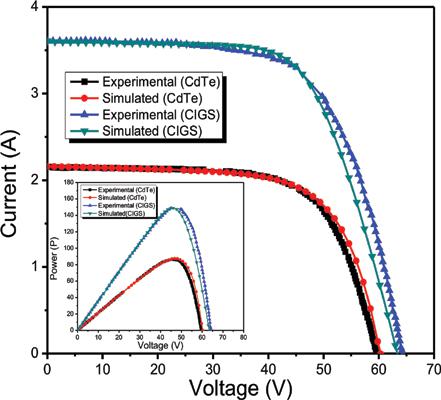Current Nanoscience ( IF 1.4 ) Pub Date : 2020-07-31 , DOI: 10.2174/1573413715666190130161402 Muhammad Naveed Shaikh 1 , Qayyum Zafar 2 , Antonis Papadakis 1

|
Background: The accurate energy yield prediction of a PV system under various environmental conditions is important for designing a high-performance PV system.
Objective: The robust and cost-effective digital simulation studies on PV systems have the advantage in comparison to studies based on measurements because they provide the opportunity for sensitivity analysis on various design parameters of the PV system.
Methods: Herein, we present the development and implementation of a generalized photovoltaic computational model using Matlab/Simulink software package. The model is based on the equivalent diode circuit approach. It is designed to simulate two ubiquitous and high performing 2nd generation photovoltaic (PV) modules constructed with Cadmium Telluride (CdTe) and Copper Indium Gallium di-Selenide (CIGS) photoactive thin films, respectively. The values of key input parameters to the simulator, i.e., parallel resistor (Rp) and series resistor (Rs) have been computed by an efficient Newton-Raphson iteration method.
Results: The output current-voltage (I-V) and power-voltage (P-V) characteristic curves of the aforementioned PV modules have been simulated by taking two input variables (ambient irradiance and temperature) into consideration. The electrical performance of both PV modules under various environmental conditions have been mathematically investigated by the solution of classical non-linear equations.
Conclusion: The developed PV model has been validated with the experimental results obtained from standard PV module datasheets provided by manufacturers. The relative error between the simulated and experimental values of various photovoltaic parameters for CdTe and CIGS PV modules at Standard Test Conditions (STC) has been observed to be below 3%.
中文翻译:

用于第二代高效光伏(PV)模块的基于Matlab / Simulink的综合模型的开发
背景:在各种环境条件下准确预测光伏系统的能量产量对于设计高性能光伏系统非常重要。
目标:与基于测量的研究相比,针对光伏系统的强大且经济高效的数字仿真研究具有优势,因为它们为光伏系统的各种设计参数提供了敏感性分析的机会。
方法:本文介绍了使用Matlab / Simulink软件包的广义光伏计算模型的开发和实现。该模型基于等效二极管电路方法。它旨在模拟两个分别由碲化镉(CdTe)和二硒化铜铟镓(CIGS)光敏薄膜构成的高性能第二代光伏(PV)模块。模拟器的关键输入参数(即,并联电阻器(Rp)和串联电阻器(Rs))的值已通过有效的Newton-Raphson迭代方法进行了计算。
结果:通过考虑两个输入变量(环境辐照度和温度)模拟了上述PV模块的输出电流-电压(IV)和功率-电压(PV)特性曲线。通过经典非线性方程的解,对两个光伏模块在各种环境条件下的电性能进行了数学研究。
结论:所开发的PV模型已通过制造商提供的标准PV组件数据表获得的实验结果进行了验证。在标准测试条件(STC)下,CdTe和CIGS PV组件的各种光伏参数的仿真值和实验值之间的相对误差已观察到低于3%。











































 京公网安备 11010802027423号
京公网安备 11010802027423号